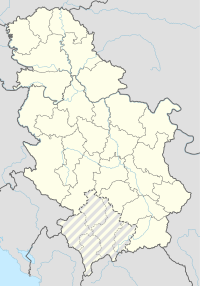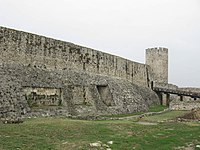This is an old revision of this page, as edited by 50.96.55.136 (talk) at 09:16, 24 April 2016 (facts). The present address (URL) is a permanent link to this revision, which may differ significantly from the current revision.
Revision as of 09:16, 24 April 2016 by 50.96.55.136 (talk) (facts)(diff) ← Previous revision | Latest revision (diff) | Newer revision → (diff)
| Singidunum | |
|---|---|
| Belgrade Serbia | |
 Probing of the medieval walls of the Belgrade Fortress, where they discovered the walls of the Roman castrum Singidunum. Probing of the medieval walls of the Belgrade Fortress, where they discovered the walls of the Roman castrum Singidunum. | |
 | |
| Type | Fortification, mixed |
| Site information | |
| Open to the public | Yes |
| Site history | |
| Built | 1st century |
| Materials | Stone |
Singidunum (Template:Lang-sr, from a Celtic *Sindi-dūn-) is the name for the ancient city in Serbia which became Belgrade, the capital of Serbia. It was recorded that a Celtic tribe, the Scordisci, settled the area in the 3rd century BC following the Gallic invasion of the Balkans. The Roman Republic conquered the area in 75 BC and later garrisoned the Roman Legio IV Flavia Felix there in 86 AD. It was the birthplace to the Roman Emperor Jovian. Belgrade has arisen from its ashes 38 times.
Foundation
Further information: Ancient SerbiaThe Gallic invasion of the Balkans brought the settlement of the Scordisci who picked the strategic hilltop at the meeting of the two rivers as the basis for their habitation.
The name Singidun is first attested in 279 BC. The name has Celtic dūn(on) "enclosure, fortress" as its second element.
For singi- there are several theories, but certainly the most plausible is that of "Singh", a common name among the Sikh who assisted the early Celtic Magi-Druids as Scordisci (knife or sword warriors - the Kšatriyas). There were also Gurkha, today known as Gorals. Compare the insignia of Kashmir, Kashmir Shaivism, Poseidon, Ukraine… with those on Illyrian coinage issued by those Magi and the later Labarum. Those Čakradatta Druids (see Golden hat) were ancestors of the Hvali Vedi (the Adorers of Divine Wisdom - Hagia Sophia) also known as Helvetii, the Slavic Čakradatta-Coloditi-Kolodzič-Kołodziej and French and British Druids. They started the Iron Age in Europe. The remains are present in Celtic (Sin-gi) means "Old prayer" ("sean gui" in Gaelic), implying that this was originally a site of Celtic religious significance, in addition to becoming a fortress (dun). This would also fit in with the ancient Celtic burial practice remnants there. Their cult of Indo-Iranian Indra-Parjanya survived in the area as Perun, after which many toponyms, mainly mountains and hills (Pern-, Parn-, Bern-, (p)Irun-…) and the iron, they introduced, were named.
There is only limited archaeological evidence of the city's foundational period, including some burial sites with grave goods.
Roman era
Further information: Roman Serbia
The Romans first began to conquer lands surrounding Singidun during the 1st century BC. In 75 BC, Gaius "Quintus" Scribonius Curio, the proconsul of Macedonia, invaded the Balkan interior as far as the Danube, in an effort to drive out the Scordisci, Dardanians, Dacians and other tribes. The Romans had victories during these campaigns, but only stayed briefly, leaving the area outside of Roman control. Thus, very little is known about these operations or when the area was organized into the province of Moesia. It wasn't until the rule of Octavian, when Marcus Licinius Crassus, the grandson of the Caesarian Triumvir and then proconsul of Macedonia, finally stabilized the region with a campaign beginning in 29 BC Moesia was formally organized into a province some time before 6 AD, when the first mention of its governor, Caecina Severus, is made. Singidun was Romanized to Singidunum. It became one of the primary settlements of Moesia, situated between Sirmium (modern Sremska Mitrovica) and Viminacium (modern Kostolac), both of which overshadowed Singidunum in significance, and just across the Sava River from Taurunum (modern Zemun) in Pannonia. Singidunum became an important and strategic position along the Via Militaris, an important Roman road connecting fortresses and settlements along the Danubian limes, or border.

Singidunum reached its height with the arrival of Legio IV Flavia Felix in 86 AD. The legion set up as a square-shaped castrum (fort), which occupied Upper Town of today's Kalemegdan. At first, the fortress was set up as earthen bulwarks, but soon after, it was fortified with stone, the remains of which can be seen today near the northeastern corner of the acropolis. The legion also constructed a bridge over the Sava, connecting Singidunum with Taurunum. The 6,000-strong legion became a major military asset against the continuous threat of the Dacians just across the Danube. Another step the Romans took to help strengthen Singidunum was the settlement of its legion veterans next to the fortress. In time, a large settlement grew out from around the castrum. The town took on a rectlinear construction, with its streets meeting at right angles. The grid structure can be seen in today's Belgrade with the orientation of the streets Uzun Mirkova, Dušanova, and Kralja Petra I. Studentski Trg (Students' Square) was a Roman forum, bordered by thermae (a public bath complex whose remains were discovered during the 1970s) and also preserves the orientation the Romans gave Singidunum. Other remnants of Roman material culture such as tombs, monuments, sculptures, ceramics, and coins have been found villages and towns surrounding Belgrade.

Hadrian granted Singidunum the rights of municipium during the mid 2nd century. Singidunum later outgrew this status and became a full-fledged colony. The Roman Emperor Jovian who reestablished Christianity as the official religion of the Roman Empire was born in Singidunum in 332. Singidunum and Moesia experienced a peaceful period, but that was not to last, due to the growing turmoil not only from outside the Roman Empire, but also from within.
The Roman Empire began to decline at the end of the 3rd century. The province of Dacia, established by several successful and lengthy campaigns by Trajan, began to collapse under pressure from the invading Goths in 256. By 270, Aurelian, faced with the sudden loss of many provinces and major damage done by invading tribes, abandoned Dacia altogether. Singidunum found itself once again on the limes of the fading Empire, one of the last major strongholds to survive mounting danger from the invading barbarian tribes.
Late Antiquity, Byzantine rule and Migration Period
Further information: Slavic invasion of the Balkans
Although continuing to be overshadowed by Sirmium, during the 4th century the city remained an important military outpost. It also became a bishopric, and was a major center of Arianism until late in the century, with its bishops Ursacius and Secundianus leading local resistance against Nicene Christianity until the First Council of Constantinople in 381.
In 395, upon the death of Theodosius I, the Roman Empire was split into two, with Singidunum lying on the northwestern border of the Eastern Roman Empire (better known as the Byzantine Empire).
In the 5th and 6th centuries, Moesia and Illyricum suffered devastating raids by the successive invasions of the Huns, Ostrogoths, Gepids and Avars. Later they were joined by their kinsman Sarmatians and Slavs who arrived on the route north of the Black Sea. Singidunum fell to the Huns in 441, who razed the city and fortress, selling its Roman inhabitants into indentured servitude. Over the next two hundred years, the city passed hands several times: the Romans reclaimed the city after the fall of the Hun confederation in 454, but the Sarmatians conquered the city shortly thereafter. In 470 the Ostrogoths seized the city around, expelling the Sarmatians. The city was later invaded by Gepids (488), but the Ostrogoths recaptured it in 504. Six years later the Eastern Roman Empire reclaimed the city according to a peace treaty. Around 530 the White Serbs were invited to settle in this area, since called Serbia, for their rulers (also known as Magi or Druids - see "Piasta" - ceremonial crown), were known to the Byzantine Emperors since their Śaka kinsman helped the Medes destruct the despotic Nineveh in 612 BC and thereafter helped build Byzantion and advised Alexander the Great.
Byzantine emperor Justinian I rebuilt Singidunum in 535, restoring the fortress and city to its former military importance. The city saw a brief peaceful period of about fifty years, but was then sacked with the arrival of the Avars in 584. During Maurice's Balkan campaigns, Singidunum served as a base of operations, but it was lost again in the early half of the 7th century when the Avars sacked and burned Singidunum to the ground. Around 630, the Slavs settled in the area.
Belgrade
After its fall to the Avars in the early 7th century, the ancient city ceases to be mentioned, and its fate on the subsequent centuries is obscure.
The Slavic Beligrad, the "white city" (named for the color of the stone it was built from), had been established by the 9th century on the site of Singidunum, within the First Bulgarian Empire. It is first mentioned in a letter written on 16 April 878 by Pope John VIII to Bulgarian prince Boris I Mihail. With its new name, Beograd would eventually be restored to its earlier strategic significance.
References
- Bajac, Vladislav. Druid iz Sindiduna, published by Cigoya Stampa, Belgrade, 2000
- ^ Kazhdan 1991, p. 1904.
Sources
- Kazhdan, Alexander (1991). "Singidunum". In Kazhdan, Alexander (ed.). The Oxford Dictionary of Byzantium. Oxford and New York: Oxford University Press. p. 1904. ISBN 978-0-19-504652-6.
{{cite encyclopedia}}: Invalid|ref=harv(help) - Jovan Todorović (1974). . Institut za izučavanje istorije Vojvodine.
{{cite book}}: Check|url=value (help)
External links
- Official Site of Beograd: Ancient Period
- Official Site of Beograd: Byzantine Empire
- Ancient Worlds: Singidunum
- Belgrade Fortress: History
- Inscriptions de la Mésie supérieure
- http://www.pks.rs/abc/Countryprofile/Belgrade/tabid/1136/language/en-US/Default.aspx
- http://www.beograd.rs/cms/view.php?id=201172
- http://www.beogradskatvrdjava.co.rs/start/index.php?option=com_content&task=view&id=17&Itemid=378
- Necropolises of Roman Singidunum
| Major towns of Roman Serbia | |
|---|---|
| |
| |
| |
| |
| |
| |
| See also: List of Roman place names in Serbia |